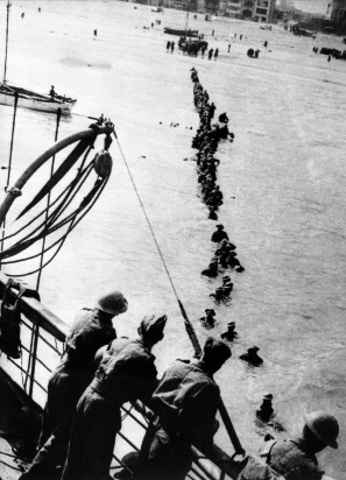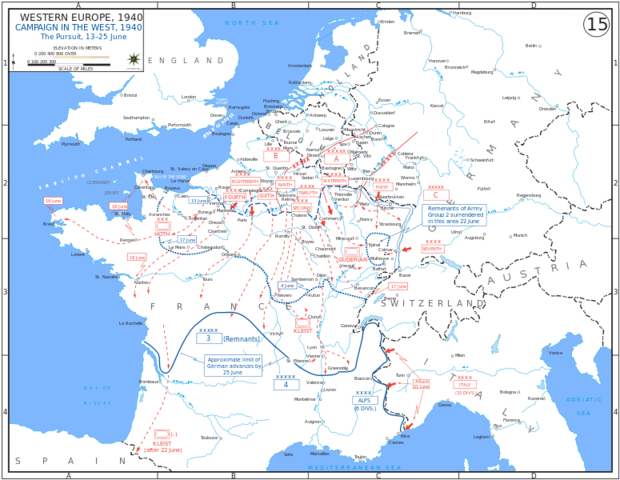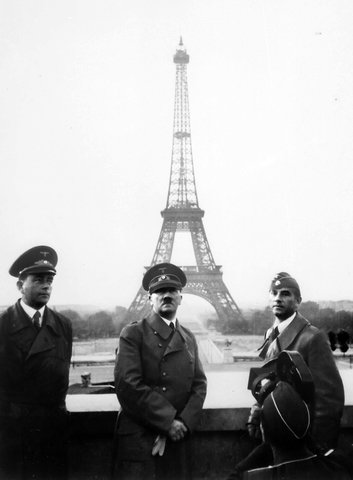4. Fall Gelb and Fall Rot (Invasion of Low Countries and France)
"There is nothing preventing the enemy reaching Paris. We were fighting on our last line and it has been breached. I am helpless, I cannot intervene."
- French General Maxime WeygandGermany, since the Treaty of Versailles, wants to have revenge against France because of their humiliation and harsh terms. And that revenge came in 10 May 1940, where the infamous Battle of France and Invasion of Low Countries start.
Hitler ordered the Invasion of the Low Countries to start at the shortest time possible. This would stop France from occupying them first, and prevent Allied air power from threatening the vital German Ruhr Area. It would also provide bases for long-term air and sea campaign against Britain.
 The Evolution of Fall Gelb
The Evolution of Fall GelbThe first plan created to attack France was the Halder's Aufmarschanweisung N°1, Fall Gelb ("Deployment Instruction No. 1, Case Yellow"), where it is very similar to Schlieffen Plan in World War I. The difference is while Schlieffen Plan use rapid movement to encircle Allied troops to win the war, Aufmarschanweisung N°1 use frontal attack, where Germany strength in 1940 will be exhausted, and the main attack begins in 1942.
Halder later changes it to Aufmarschanweisung N°2, Fall Gelb, where it have a secondary attack on Netherlands.
Later, Manstein with the help of Guderian created a plan which he transmit to OKH (Oberkommando der Heeres), OKH denied the plan.
Hitler had actually suggested that the main assault be concentrated in Sedan, much like Manstein Plan. When the Manstein Plan were finally showed to him, he agreed to all Manstein suggestion. This plan becomes the Aufmarschanweisung N°4, Fall Gelb. This plan provokes a stream of protest by the majority of generals.
The Germans also employed the Blitzkrieg, where the concentrated mass of tanks with the help of airforce and artillery push forward in speed and surprise, rapidly pierced the enemy front while regular troops followed, finishing any enemy troops left also widening the gap in the enemy frontline. This tactics provokes fear and panic in the enemy frontline, also the dynamic and rapidly changing frontline makes the enemy harder to prepare defences.
The French still believe in World War I tactics, where they put the majority of their Army budget to the Maginot Line, a line of static defenses encompassing the French-Italian and French-German border. This mean their Ground Forces and Airforce recieved the end-of-the-stick budget, resulted in outdated tactics and outdated communication system. The French also spread their tanks to their infantry divisions, not concentrated like the Germans.
 Maginot lines
Maginot linesThe French and British defensive strategy against the Germans was to deploy most of their Elite Forces to the Dutch and Belgian territory, where they will engage and defend against the brunt of German forces. Also the British, French, and Swiss intelligence identify 6-7 German Panzer Battalion near the German-Luxembourg border. This hardened the French assumption that Germany will attack Belgium like in the World War I.
 Dutch defensive lines
Dutch defensive linesFall Gelb started in 10 May 1940, Luftwaffe attacked all airfields in Netherland and Belgium territory. This attack were very successful, as Luftwaffe later have air superiority unopposed. The German 18th Armee later secured all the vital bridges toward Rotterdam, which penetrated Fortress Holland and bypassed the New Water Line from the south. But, an operation to capture the Dutch Government, known as the Battle for The Hague, ended in complete failure. 50% of the Fallschirmjager strength were depleted.
The French Command reacted immediately, and executed the Plan D. But when the French Forces arrived in Dutch border, the Dutch Forces were already in full retreat. They finally mount an assault toward the reinforcement of German 9th Panzer Battalion, which arrived at Rotterdam. An independent Dutch counterattack also failed. In 14 May 1940, Dutch Army surrendered.
While in Belgium, in 10 May 1940, Germany deployed Fallschirmjager to eliminate the Fort Eben-Emael, considered the most modern fort in Europe that time. They landed using gliders, and breached the fortress using explosives and flamethrowers. The 82-man Fallschirmjagers successfully eliminated the main line of Belgian defences with 1200 garrison.
After the Eben-Emael eliminated, Belgian Supreme Command withdrew its divisions to the next defensive line five days earlier than planned. The Belgians later surrendered in 26 May 1940, after the encirclement and withdrawal of Allied forces.
While in the Ardennes, the progress of German Army Group A was delayed by Belgian and French troops, and by their forces too. The sheer number of German forces made the advances nearly stuck, as there are only 4 lines to attack and march. In this time, the Germans were so vulnerable by enemy air forces, but the French did not attack, as the French Bomber Squadron was to weak to challenge the Luftwaffe.
Gamelin knows the importance of Ardennes sector, and he moved all of his reserve forces to reinforce the Meuse sector, a strong defensive line 6 km deep.
The Germans struck the Meuse sector in 13 May. German XIX Korps forced three crossings near Sedan. The Luftwaffe smash a hole in the narrow French line. In here, the most intense bombardment occurred, A total of 3,940 sorties were flown by nine Kampfgeschwader (Bomber Wings) in this battle alone. The Germans quickly poured into this hole. The morale of French defender had been broken by the air attack, and surrender en masse.
General Gaston-Henri Billotte, commander of the 1st Army Group, urged that the bridges across the Meuse be destroyed. Every available Allied light bomber was employed in an attempt to destroy the three bridges, but failed to hit them while suffering heavy losses. 44 percent of the Allies bomber strength was destroyed.
After breaching the Meuse line, Hitler ordered his forces to dig in. Rommel and Guderian ignores this order, and continued to attack. This decision proved crucial to the German success. In 14 May, Guderian and Rommel began to advance to the English Channel. On 15 May, Guderian's forces assaulted the reinforcements of the newly formed French 6th Army in area west of Sedan, cutting the southern flank of the French 9th Army. The 9th Army collapsed and surrendered en masse. The French 2nd Army had been seriously damaged and not fit for combat, and the 9th Army was retreating. Rommel forces had successfully dispersed the French Armies within 24 hours. This let the Rommel 7th Panzer Division "Ghost Division" to advance unhindered day and night. In 24 hours, they had advanced 48 km.
 Rommel in Sedan, France, discussing assault with his staff.
Rommel in Sedan, France, discussing assault with his staff.By 17 May, Rommel claimed to have taken 10,000 prisoners and suffered only 36 losses. Guderian encouraged his XIX Korps, consisting of the 1st, 2nd, and 10th Panzer Divisions to head for the channel, continuing until their fuel was exhausted. They used 17–18 May to refuel, eat, sleep and return more tanks to working order. In 19 May, German forces couldn't stay inactive, and now strikes at the weak British 12th and 23rd Territorial divisions located on the Somme river. Guderian and Rommel's forces had reached the channel in 11 days.
 British troop evacuating from Dunkirk
British troop evacuating from DunkirkOn 23 May, Hitler ordered halt for his forces to resupply, rearm, and fixing broken down tanks that will assault Allied forces in Dunkirk.
The British commenced Operation Dynamo in 24 May, to evacuate Allied soldiers that were encircled in Dunkirk area. Every ship that were suitable for transport are used to evacuate the Allied soldiers in this largest naval evacuation in history. 56.000 soldiers were evacuated in the first day alone, the total evacuated soldiers were 338.000. The Luftwaffe tried their best to stop the evacuation. They flew 1,882 bombing and 1,997 fighter sorties and sunk 89 merchant ship and 29 of the 40 destroyers in the Royal Navy.
 Fall Rot plan
Fall Rot planThe French, after the BEF withdrawal, lost 61 of their most advanced and superior division. However, when the Germans renewed their offensive in the Somme, the French with only 64 divisions left were able to inflict heavy damage to German troops. The troops and commanders are experienced and they used their advantages to the most. But, the French civilians, fled from the front en masse and clogged all the way to the South. This made the French delayed their transport of supply several times, which resulted in some French batallions were low on supplies.
Army Group B attacked the side of Paris. But, after 48 hours, it had not made any breakthroughs. The Germans struggled to get over the Aisne. Then, the Germans relied over the Luftwaffe again, to silence the French heavy guns. The Luftwaffe helped the Germans to disperse the French. Weyward fear any massed troop position will be bombed by Luftwaffe.
On 10 June, the French government declared Paris an open city. The French still resisted the Germans to enter the city strongly, but in 14 June, Paris fell.
 German troops in Paris
German troops in ParisThe British later commenced another evacuation, Operation Ariel. Luftwaffe resisted this evacuation with all they had, but still failed to prevent the evacuation of 190.000-200.000 of Allied troops.
The British propose a French-British Union, to prevent the French surrender to the Germans. French Prime Minister Paul Reynaud accept this, but his cabinet strongly disagree, claiming it's a last minute British attempt to steal French colonies. Paul Reynaud, felt that his ministers did not support him anymore, resigns. He was succeeded by Marshal Phillipe Petain, which eventually signs armistice with the Germans in the Forest of Compiegne, where the defeated German Empire signs its armistice in 1918. Hitler sat in the same chair, where Marshal Ferdinand Foch had sat when he faced the German representatives. After listening to the reading of the preamble, Hitler left the carriage, like the French did in 1918.
 Hitler in Paris
Hitler in Paris
France was divided into a German occupation zone in the north and west and a "free zone" in the south. All of French coastal territories is controlled by the Germans, for the Kriegsmarine bases. The South was a French state headed by Pétain that replaced the French Third Republic. This state is often called as Vichy France.
Hitler had expected a million Germans to die in the Invasion of France, instead, his goal was accomplished in just six weeks with only 27,000 Germans killed, 18,400 missing, and 111,000 wounded, a little more than one third of the total German casualties in the Battle of Verdun during World War I. This resulted in wave of euphoria among the German population and a strong upsurge in war-fever, that the Germans were close to victory, with only Britain left in the war.
The British morale were hit, as the then undefeatable BEF were now fleeing with haste from the European Mainland. The British also feared that the French Navy would be seized by the Germans, as the French Fleet were the second most modern fleet in Europe and were deemed dangerous to be keep intact. While the French assured that the French Fleet would be scuttled, the British set sail to the French harbors and attacked the French Fleet. The French were told to stand down, and assist in the British operation. While most of French sailors did what they had told to, some of them refused, and opened fire against the British.
The Italians declared war on France in 10 June. The offensive were repulsed by the French. Why? It will be discussed in the next episode.